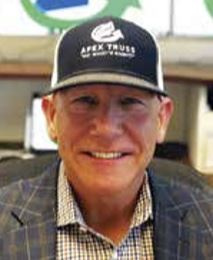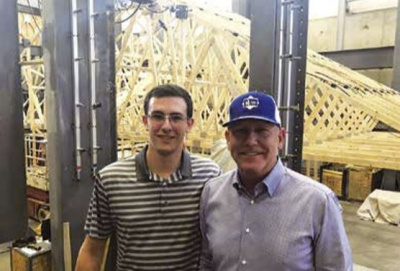Faces of the Industry: Larry Dix
Faces of the Industry: Larry Dix
Owner • Apex Truss • Warsaw, Virginia

How’d you get into this industry?
Since I was 14 years old, I just wanted to own my own business. In 1986, I was selling lumber in Texas when the economy collapsed. With the market tanking, they laid off half of the employees. I was fortunate, I was pushed back down to retail sales but I wanted to get back into outside sales. The company’s truss plant began to struggle and I was asked to sell trusses. I said yes, despite not knowing what a truss was, and I have never looked back from there.
Before selling them, I worked in the truss plant for 90 days and lost 20 pounds. By 1987, Dick Marriott and Bob Dayhoff hired me to work with them at Shelter Systems in St. Louis. Over the next year, I rode around with Dwight Hikel and Lenny Sylk, where I was highly influenced from some very powerful people at a very young age.
In 1989, at 26 years old, I went back to Texas and ended up running the truss plant at Calcasieu Lumber because I was the only person at the company who had dealt with trusses before.
I was hired in 1994 by Stripling-Blake Lumber Company to build a truss plant for them from the ground up. I eventually made my way to Virginia to build a plant for Trussway and chose to plant roots here. When the local truss plant closed in 2000, I bought it and began my company, Apex Truss.
Blind ambition is a wonderful thing. At 55 years old, I probably wouldn’t do it like I did back then, but I never thought failure was an option and was willing to give it a try. That’s the beauty of our industry; it’s such an entrepreneurial experience for so many people.

Larry and his son, Jared, recently visited SBCRI and SBCA staff offices. Larry has supported Jared’s involvement in SBCA’s Emerging Leaders program and is doing everything he can to expose him to all facets of the industry.
What’s your favorite part about being in this industry?
My most favorite part is the advancement of technology and potential to build trusses with robots in the next ten years. I see so much opportunity for our industry. We often hear that the construction industry is the most inefficient industry in the world. Trusses are one of the few things that can bring efficiency to the industry. If you just look around, we are doing cutting-edge things, where others are still banging things out with hammers and nail guns. We are one of the bright spots of construction because we are a manufacturing facility that does everything through processes and procedures.
What could you do without?
I could do without big government interference and regulation. The bureaucrats in Washington are always trying to tell us how to run our businesses better, even after we’ve proven to be successful. They also don’t usually ask us what we want, they just tell us. Despite all that, I have had some luck building relationships with my local lawmakers and have found those connections can be valuable.
What’s your company, market, or SBCA chapter focused on right now?
The company is 100 percent focused on labor and technology. The two are intertwined as we are trying to increase head count while, in the same breath, increase our efficiencies to get more bang for our buck for every person we can get in the truss plant. This is applicable with design, delivery, and every other facet of the operation. We use a Slack channel to communicate and make internal decisions quickly. We also track information from throughout our company using multiple software platforms. Our goal is to try to make sure we are making decisions that are in the best interest of Apex and are not dependent on the interests of any one of our suppliers.
What challenges do you see for the industry in the future, and what should SBCA be working on now to meet those challenges?
Short term? Labor. Long-term? We have to create data standards of some sort to be able to ride the wave of technology, which is coming whether we want it to or not. Somehow, we also have to address the monopoly that currently exists with our plate manufacturers and software companies. We need to bolster the entrepreneurial spirit and ensure manufacturers control their destiny and aren’t dependent on any one supplier. Both lumber and plates have a big impact on our business and currently too few companies have too much control. My hope is technology will spur the entrepreneurial spirit again and we’ll see a massive leap in the manufacturing process. Gantries were invented in the 1960s and we’re still building on them. We have seen revolutionary advancements like pucks, projectors, and lasers, but the car industry was revolutionizing 35-40 years ago, and we’re just now trying to get there.
SBCA should continue to work toward shepherding truss plants so we are all heading in the same direction and are unified in pushing our suppliers to support their customers and help them grow their individual businesses.
As an industry, we all need to be pushing the sled in the same direction and continue to focus on whatever the challenges are. We have to see problems before they arise. To do that, we need more members to travel to OQMs and attend BCMC. Because our industry is so small, we have to speak as one, or nobody will listen. Fifty solutions from fifty people doesn’t solve industry problems. We have to get more people involved, particularly youth, and have them help us fight that cause through the media available to us. We’re all fighting the same fights, just in different parts of the county.
When you’re not thinking about trusses, what keeps you busy?
I like to challenge myself mentally and physically. How are you going to be any better if you don’t surpass your top line? I’m an athlete; I like to swim, bike and run. I also love to read. I have very unrealistic expectations for myself and everyone around me, including my family.

